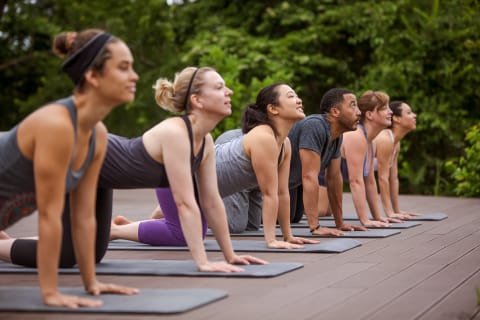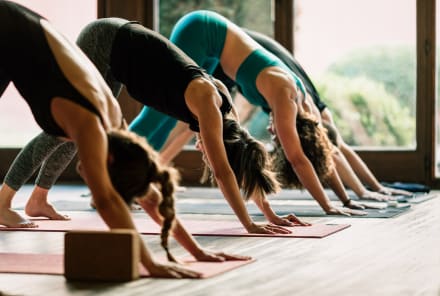Advertisement

I’m working with a group of new yoga teachers in training who will be graduating this month. In talking to a few of them as their training comes to a close, they all had questions about “next steps.” Most of them will be continuing with their full-time jobs but many have visions of moving into teaching more regularly, if not as a career.
The time right up until your graduation and shortly thereafter is critical for new graduates. You’re still ‘high’ on your accomplishment and still connected to your fellow teachers through regular contact. You’re energized by your experience and ripe to plan your next steps in your yoga career. Here are some steps to take once you’re done:
1. Get your certificate from the teacher training program you’ve completed and start your Continuing Education folder
Most, if not all, Teacher Training Programs will give you a certificate to indicate that you graduated and will include the dates of attendance and the name of the school itself. Once you receive this, make a few color copies and get them either laminated or protect them in a plastic slipsheet. Secondly, start a folder where you’ll keep all documents related to completed trainings. Over the years, there will be more trainings you’ll attend and it’s helpful to have all these documents in one place.
2. Submit your information to Yoga Alliance to become registered as a yoga teacher
Most of the yoga schools conducting training are registered as yoga schools with Yoga Alliance. This is not always the case but you probably checked this out before you attended the training. If your school is registered, you can go online to the Yoga Alliance website and submit your graduation information so you can become a Registered Yoga Teacher.
3. Get your liability insurance
It’s critical you have liability insurance. This protects you when teaching and most studios will ask that you provide a copy of this document. One company that provides insurance is Philadelphia Insurance Company but there are others as well. The cost of this insurance is minimal when compared to the dollar limits provided in coverage. Once you receive this coverage statement (especially if it’s emailed to you versus mailed), be sure to print or copy the coverage page (it will be a large document but the first few pages are the important ones) and include this in your folder (as above).
4. Create your Yoga Resume
In my Bare Bones Yoga Teacher Mentorship Program, I have a module called “Resume Creation and Marketing,” which helps teachers create a comprehensive profile of their professional and teaching experience. Even for new teachers that have not yet begun to teach, there is much that can be included on a resume. Include your professional experience, but slant the content towards skills that can be transferred to teaching. Include your training and it’s focus and a statement about your teaching style.
5. Determine your minimum rate for teaching
This may sound like a crazy thing to do when you have no experience but this is more of an exercise in understanding the yoga industry, the range of rates for teachers in your area and in different settings and also forcing you to consider your value, your costs and your overall revenue needs from yoga teaching. This rate will change as you gain experience, but the factors that go into determining your rate will not.
One note: Just because you decide on your minimum rate, doesn’t mean you may decline a job if they aren’t willing to pay that. As a new teacher, there are other reasons to take a job, namely, to get experience. However, if the rate is below your minimum, you might want to factor into the agreement with your client the right to re-evaluate the rate after 6 months.
6. Start assisting on a regular basis
I think this is one of the most important things that new teachers can do in order to keep active, keep learning, gain experience, network with other teachers, learn alignment, observe experienced teachers and be “of service” (among lots of other benefits). Ask your local studio (or the host of your teacher training) if you can assist in classes. If yes, be ready to commit to a regular class, on a regular basis. Assisting should be viewed as a responsibility, not a “do it once every once in a while” kind of thing. If you don’t think you have the time to commit long term, at least commit to a few months. The requirement to “show up,” regardless of your personal life, your schedule, your attitude that day and how you are feeling is all part of teaching and assisting. You won’t be paid but you might gain credits for free classes and you gain tons of experience you can add to your resume.
7. Create a spreadsheet of professional contacts
Start a spreadsheet of contacts in the yoga industry. Include your colleagues from training, teachers you’ve met, people you admire. If your list is short, start networking! Look for new studios to visit, local workshops to attend and ask people to lunch.
8. Network and meet to secure one paying teaching gig
Use your contact list as one way to find a job. Get on every local studio substitute list you can. Peruse Craig’s List and Indeed.com for yoga jobs.
9. Start teaching on a regular basis, at least once per week (even if it’s for free)
If you’ve not had luck finding a paying job, set up a weekly class for your friends or a local community group. Even a donation-only class will start to get you teaching. The longer you wait to start teaching, the harder it will be. You’ll forget the sequence, you’ll lose your nerve and you’ll get fearful about starting.
10. Set up a regular practice schedule at your home based studio
With all the focus on learning, don’t forget that being a student of yoga is a huge part of your training. It’s also a great way to network and meet other yoga teachers. If you don’t have a studio that was the host of your training (and is your ‘home base’ for your practice), find one. And, if you have a studio at which you’d like to teach, start practicing there. You’ll make connections with everyone from the person that does check in to the teachers and clients. Becoming a “known entity” is a big part of getting hired for a teaching job. While you’re building connections, you’re also practicing yoga.
Graduating from a teacher training is a wonderful accomplishment. You’ve invested substantial time and money into the program. Yes, there are many things you yet to learn but the best way to learn is to get out there! Have faith, be courageous but most important be yourself!
Watch Next
Enjoy some of our favorite clips from classes
Enjoy some of our favorite clips from classes
What Is Meditation?
Mindfulness/Spirituality | Light Watkins
Box Breathing
Mindfulness/Spirituality | Gwen Dittmar
What Breathwork Can Address
Mindfulness/Spirituality | Gwen Dittmar
The 8 Limbs of Yoga - What is Asana?
Yoga | Caley Alyssa
Two Standing Postures to Open Up Tight Hips
Yoga | Caley Alyssa
How Plants Can Optimize Athletic Performance
Nutrition | Rich Roll
What to Eat Before a Workout
Nutrition | Rich Roll
How Ayurveda Helps Us Navigate Modern Life
Nutrition | Sahara Rose
Messages About Love & Relationships
Love & Relationships | Esther Perel
Love Languages
Love & Relationships | Esther Perel












